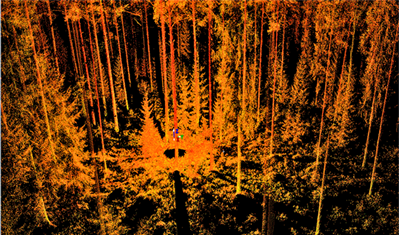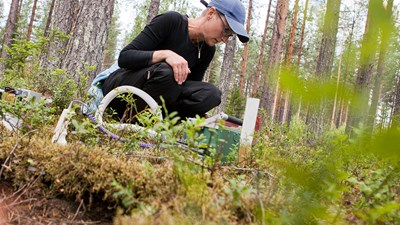Collaboration SLU–Stora Enso

Initial collaboration areas
The Faculty of Forest Sciences at SLU holds a strong position internationally, with by far the largest number of publications within the field of forestry. It is safe to say that SLU is one of the leading universities within the field.
Stora Enso is a leading global provider of renewable solutions in packaging, biomaterials, wooden construction and paper. The company employs some 26 000 people in more than 30 countries and is a major Swedish forest owner.
The main objective of the collaboration is to jointly run research projects to develop new knowledge within sustainable forestry and wooden biomaterials. Moreover, the collaboration will act to strengthen competence development of staff members at Stora Enso and SLU.
The strategic collaboration focuses around four integrated collaboration areas:
Biodiversity – forestry with increased nature values
In this platform, we conduct research in forest conservation biology, with a focus on Fennoscandian conditions. We assess the efficiency of conservation-oriented forestry measures, methods for restoration of conservation values, and of setting aside forest from forestry. As response variables, we use both fauna and flora of conservation concern and forest structures that reflect conservation values. We work with field experiments, large-scale field survey data, and syntheses of scientific literature. The collaborators from SLU belong to Dept. of Ecology in Uppsala and Dept of Wildlife, Fish, and Environmental Studies in Umeå.
Growth and yield-adaptive forest management
Silviculture of Scots pine and thinning strategies
This is a research project with main focus on increasing the understanding of interactions between tree growth and response to competition release. The aim of this PhD-project is to create knowledge for improved thinning guidelines that are adapted to a more precise forest management based on individual tree information from remote sensing, rather than guidelines on a stand level. The aim is also to create knowledge how thinning can be done to better meet consequences of climate changes and extreme weather events
Four objectives are formulated for this 5-year long project:
- Growth effect of thinning on trees of different size classes in Scots pine
- The importance of spatial distribution after thinning when comparing growth of individual trees.
- Timing of thinning response of different above-ground parts of individual trees.
- An understanding of mechanisms behind thinning response is crucial for the construction of future thinning guidelines.
Most thinning experiments in Sweden, and internationally, are empirical studies where effects of various thinning strategies on volume production and economy are investigated. However, with a changing climate, empirical knowledge will be more difficult to put into practical operations because future environment may be different from the environment at the time of the study.
Water- and nutrient availability are both affected by the thinning operation, and by climate change. Today, we have very little mechanistic knowledge about thinning-response. Most growth-function have an underlying assumption of competition for light, but many experiments indicate that competition for water and nutrients below ground are equally or more important. The response of individual trees after thinning is of fundamental importance for the construction of future thinning guidelines on pixel- or individual tree scale. Therefore, a more basic understanding of thinning-response is needed in order to construct thinning-guidelines that will be near optimal in future climate.
In this project, we will contribute to the mechanistic understanding of thinning-response which in turn may be necessary in future adaptation of forest management to climate change. This will be done through a new thinning experiment in Scots pine will be established in the Siljansfors experimental forest. In addition to growth parameter such as height and diameter, several ecophysiological parameters will be registered. The aim is to record change in availability of light, water and nutrients as a response to thinning, and explain individual tree thinning responses with these parameters.
Amanda Segowich is a newly recruited Ph. D. student with a background from the University of Sao Paolo, Brazil. The research group is mainly situated in Alnarp at Southern Forest Research Centre but the main study area are situated at Siljansfors experimental station. In addition, the experiments included in this project are distributed all over Sweden.
Contact
Emma Holmström +4640415114
Ola Langvall +46 472263180
Remote sensing - technology and use in forestry
Society faces a major challenge with a shift from manufacturing based on fossil raw materials to a bio-based economy. Stakeholders need precise information to control the use of renewable natural resources, partly to strengthen sustainable use and partly to match forestry activities with specific industrial processes. The digitization makes it is possible to optimize a diversified use of forest raw materials while avoiding negative environmental effects. We work with remote sensing methods using combinations of airborne and ground-based sensors to extract quality information of individual trees. The aim is to develop automatic, cost-efficient, and accurate methods, which provide mapping of forest resources.
Life cycle assessment – forestry and climate
Life cycle assessment – forestry and climate
Overall goal
Forestry has a key role in a future bioeconomy, by providing wood fibres for biomaterials and bioenergy. The climate effects of forestry and wood-based products is however debated. One explanation for contradictory viewpoints is represented by different methodological settings in climate impact calculations, for example regarding system boundaries and chosen time perspective.
This research project will assess the climate effects of forestry and wood products applying a broad system perspective including value chain emissions, biogenic carbon stocks in forest land and temporarily stored in wood products, and the potential climate benefit from replacing greenhouse gas-intensive materials and energy, which is called substitution effect.
The climate effect will be assessed from a life cycle perspective using a time-dependent method, meaning that the timing of greenhouse gas fluxes are considered and the climate impact is expressed in temperature change over time (in addition to CO2-equivalents). Forest carbon dynamics and biogenic carbon stored temporarily in wood products will be modelled over time. Moreover, new substitution factors will be developed for different types of wood products.
Climate effects of a forestry company – collaboration report
The aim of this report was to assess the climate impact of a forestry company (Stora Enso) using a full system perspective, meaning that value chain emissions for producing wood products and bioenergy, biogenic carbon fluxes from forest land and carbon temporarily stored in wood products were considered. Additionally, the potential climate benefit from substitution was considered, which means avoided emissions when wood is used instead of greenhouse gas-intensive materials and energy.
Life cycle assessment was basis for the analysis and the results show that the estimated climate effect at corporate level was a net removal of -11.5 million Mg CO2-eq per year (meaning a climate benefit). Uptake of biogenic carbon counteracted around 40% of the value chain emissions, while the largest climate benefit (removal of 17.9 million Mg CO2-eq) was due to substitution of more greenhouse gas-intensive products. The study adds to previous research by developing several new substitution factors for paper and pulp products and by performing dynamic modelling of forest carbon stock changes and temporarily carbon storage in harvested wood products.
Hammar, T., Hansson, P.A., Seleborg, M. & Stendahl, J. (2020). Climate effects of a forestry company – including biogenic carbon fluxes and substitution effects. Report 114, Dept. of Energy and Technology, Uppsala. Swedish University of Agricultural Sciences (SLU).

Job positions
In the collaboration we offer the possibility to work in an international, top ranked research environment. We are very pleased to offer several positions within this dynamic collaboration. As a member of the research groups you will be part of an integrated team of senior researchers and practioners from both SLU and Stora Enso. Currently we are recruiting a total of 5 postdocs and 5 PhD-students within this collaborative project.
Positions currently open for application:
No positions currently open.